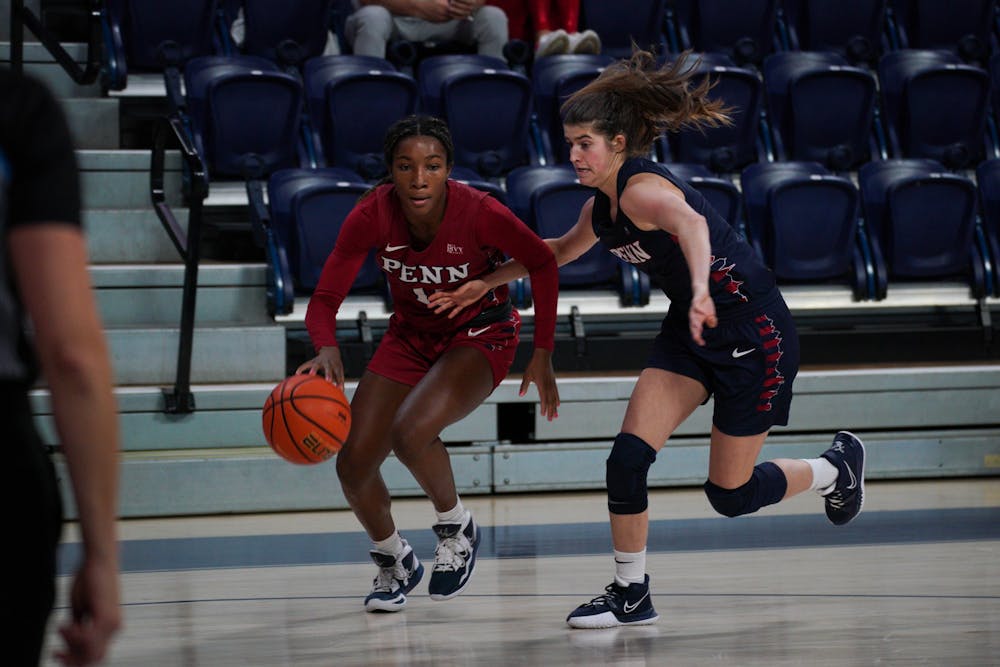
As a Division I institution, Penn prides itself on being competitive in many sports. The recruitment behind building these strong teams is a nuanced process on its own, from reaching out early to potential prospects and maintaining relationships with strong high school athletic programs. Yet many of Penn’s most successful sports teams also feature several walk-on athletes on their rosters; those who were not committed to or recruited prior to coming to Penn.
Teams with larger rosters are more likely to accept walk-on athletes, such as cross country and wrestling. Two freshman walk-on athletes, Isabel Gomez, a point guard for women’s basketball, and Hailey Kim, a coxswain for men’s heavyweight rowing, described their experiences on joining their teams after receiving their Penn acceptance letters.
Both Gomez and Kim were in contact with coaches long before even stepping foot on campus. Kim emailed the coaches of all three rowing teams — men’s heavyweight, men’s lightweight, and women's rowing — as soon as she was accepted to Penn. After several rounds of contact, Kim decided to hone in on the men’s heavyweight team. She called the coach a few times before arriving on campus and was then formally invited to join the team.
While the crew teams at Penn are more frequent takers of walk-on athletes, the men’s heavyweight team does not usually welcome as many. Kim was the only freshman walk-on for the first few weeks of the season.
“It is quite hard for the heavyweight team to take walk-ons because we don’t have enough coaches for walk-ons who are completely new to the sport,” Kim said.
Gomez's journey onto women's basketball was slightly different. Gomez reached out to the women’s basketball team coaches during her junior year of high school when she realized she wanted to play college basketball and was interested in Penn as a school overall.
Penn's basketball teams also typically maintain a smaller roster of fewer than 20 players, so the process of walking onto the team involves a lengthy tryout.
Tryouts began the first week of September and lasted around two weeks. Gomez had spent the entire summer training in anticipation of her tryout this past fall, and her hard work paid off when she made the team.
Gomez felt welcomed once she began, despite onboarding after the summer when teams usually find time to connect with the newcomers.
“I felt immediately welcomed on the team after I made it,” Gomez said. “I'm really happy I was able to get on. It’s a great community and I’m glad to be a part of it.”
Being a student-athlete at Penn demands a great deal of responsibility and proper time management. When a player walks on, whether or not they will have time to stay on top of their work is a huge factor in their decisions. Penn does not designate a particular time in the academic schedule for sports practices or club activities, so athletes must arrange their time wisely.
Fortunately for Kim, she is only required to attend morning practices and not afternoon practices, given her position as a coxswain on the team.
“Rowing practices are all in the morning, so managing my classes with practice has been fine so far,” Kim said. “Not having to attend afternoon practices has been helping a lot.”
Gomez also described her experience with balancing classes and her practice schedule, though the women’s basketball team is not in the heat of their season yet, so time management will begin to get more challenging.
“It has been an adjustment balancing classes, but I'm trying to stay organized to make time for everything,” Gomez said.
The process of walking on a sports team at Penn varies by sport. Walk-on athletes across all athletic teams at Penn have to adjust to joining a pre-established team and roster, as well as managing their rigorous academic work with their new schedule. Doing so requires incredible discipline, organizational skills, and adaptability — which only a select few have enough diligence and determination to confront.
The Daily Pennsylvanian is an independent, student-run newspaper. Please consider making a donation to support the coverage that shapes the University. Your generosity ensures a future of strong journalism at Penn.
Donate







